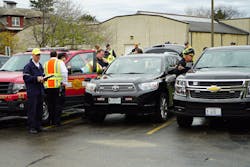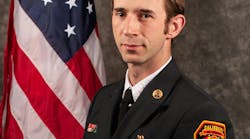The active-shooter event (ASE) is a challenging incident for the fire service. It requires us to interweave our operation with that of law enforcement. For years, the fire service and law enforcement have been working side by side but typically staying within their own areas of expertise. With the frequency of active threat events continuing to increase, saving as many lives as possible, as quickly as possible requires that we train and work together as a single team.
RTF training
Mutual-Aid Box Alarm System (MABAS) Division 3, located just north of the City of Chicago, consists of 17 suburban fire departments. Over the last two years, we have conducted significant training for ASEs. MABAS Division 3 developed a partnership with the Illinois Tactical Officers Association (ITOA)—a highly respected training entity within the Illinois law enforcement community—to create and deliver a comprehensive rescue task force (RTF) training program. This provided us with instant credibility with our law enforcement partners, resulting in good participation during the training evolutions.
The original intent of the training was to provide our firefighters and police officers from 17 area communities with a basic understanding of the RTF concept and treatment modalities for the wounded. The combined training evolutions focused on the practical skill sets required for firefighter/paramedics and police officers to work as a team within the crisis site.
The training stresses the following concepts:
- Three stages of an ASE: Crisis, Stabilization and Recovery
- Establishing a unified command as soon as possible
- Being ready to help the wounded as soon as the active threat is stopped (too often, there is a delay between the time the offender(s) is neutralized and the RTF is mobilized)
- Stopping the bleeding
- Getting wheels under the patients
We know these concepts work and have seen it demonstrated at the Las Vegas incident in October 2017, with wheelbarrows used to move victims. Although the Boston Marathon was not an ASE, it also demonstrated the importance of quick access and treatment of the victims. According to Kurt Schwartz, the director of the Massachusetts Emergency Management Agency, “Three people died instantly and 260 were injured, many of them critically. How is it that all 260 survived? ... The decision was made to move these people as quickly as possible.”
We quickly realized that we needed the chiefs to buy into this training. As a result, we developed a course for chief officers titled “Rescue Task Force: Command and Control.” This class focused on the command structure and long-term needs. It consisted of a PowerPoint presentation, videos and a tabletop exercise. The class always resulted in productive discussions. Even the “non-believers” acknowledged the importance of this training and went on to endorse it. Both classes were well attended by fire and police officers from all 17 communities.
Command focus
We conducted an active-shooter drill at a nearby military base. The drill was attended by 100-plus participants from both fire and law enforcement. As we evaluated our process, we noted that we had provided ample training for our chief officers, firefighters and police officers. However, we missed the middle managers, typically the battalion chiefs, police sergeants or lieutenants who are the first responders responsible for the initial set-up of incident command. We realized our training had not adequately prepared the initial incident commander (IC) for setting up command of an ASE.
For the most part, the fire service does an excellent job in the command process. However, an ASE requires some additional command components be implemented at the onset for it to be successful. The first-arriving fire IC will assume command. Law enforcement still struggles to assign a person to command an incident until the “Crisis Phase” is over. The reality is we want them to do whatever they need to do to stop the threat. In the meantime, we instruct the first-arriving fire IC to locate a viable command post and assume command. Once the police have a supervisor available, he or she will join the fire department in the command post to create a unified command and begin to implement RTFs and to plan for triage, treatment and transportation (TTT) of the injured.
For the IC to be successful, they will not be able to single-handedly manage the overall incident and the RTF or TTT deployment. The span of control is too great. The IC needs to delegate the RTF “command and control” to a division. That division should consist of a fire and police supervisor working “shoulder to shoulder.” All RTF and TTT radio traffic should be funneled through this division. The function of the IC is to make sure they have the resources they need to fix the problem. Within any command structure, there should only be one entity with the word command in its radio designation. Therefore, whoever commands the RTFs, their radio designation should be Forward Ops, RTF Division or RTF Supervisor (or something similar).
Ideally, the initial IC will assign personnel to supervise the RTF and the TTT areas. Those individuals will report directly to the IC. Any RTF Team will report to Forward Ops. The Forward Ops Supervisor can speak directly to the Medical Group Supervisor to alert them of incoming patients or to determine capacity. The RTF Division and the TTT area should be on a separate fireground or tactical channel. Note: The intent of this article is not to present a class on a National Incident Management System (NIMS)-compliant command structure. Rather, it is to stress the importance of assigning a Forward Ops consisting of a fire and law enforcement boss to take control of the RTF process at the crisis site. A single IC will quickly be overwhelmed without this division of labor.
It is important to add that if there is not a good line of communication with law enforcement, there will be a delay in getting medical attention to the patients. The most important piece of information for the fire IC is that the active threat has been stopped and/or the shooter contained and the warm zone has been designated. Without this intel from law enforcement, there will be a delay in getting medical assistance to the wounded. Fire and police must be operating on the same page and making sure each agency is sharing information as quickly as possible. When performing a drill or exercise in your community, this critical intel needs to be emphasized and communicated.
The Forward Ops process
Once a fire and law enforcement supervisor is assigned to Forward Ops and assigned a tactical channel, both supervisors need to be operating close to each other (face-to-face communications) to be effective. Each has certain knowledge and responsibility in the position:
Law enforcement supervisor responsibilities
- Determines the zone designations in which the RTF can operate
- Assigns the police personnel
- Determines the areas requiring additional security or protection
- Determines any current threats
- Requests additional police resources
Fire supervisor responsibilities
- Knows the capabilities of fire personnel
- Recognizes whether the RTF has the proper equipment and protection
- Communicates directly with the IC
- Can request additional fire resources
Combined responsibilities
The law enforcement and fire supervisors will be receiving intel throughout the incident and will be able to compare notes to avoid redundant or erroneous information. Both need to determine the patient-movement strategy, and both will deploy and track the locations of all RTF teams. As a single point of deployment, the RTF team should not end up going over the same area multiple times.
To track multiple RTF teams, each can be assigned a radio designation such as RTF 1, RTF 2, etc. The size of the RTF can vary depending on the resources available. A minimum of two police officers and two firefighters can make-up an RTF. Ideally, two or three police officers with three firefighters can treat more patients. When it’s time to move large numbers of patients, an RTF might consist of three to six police officers and four to six firefighters. Since an engine company is already operating as a team, assigning them as an RTF works well. They will need to be equipped with a go-bag and ballistic gear. A stair-chair and stretcher will allow them to move two patients quickly.
Gear needed
Unfortunately, we still find many departments that have not purchased trauma dressings and other equipment for ASEs. Many departments have also not secured ballistic gear for these situations. Although there is no standard at this time for ballistic gear, it is a good idea to purchase enough for at least one RTF team. Some departments have justified the purchase of ballistic gear by creating a standard operating guideline (SOG) that requires firefighters to wear the gear on other types of calls, such as a domestic situations. One suburban department near Chicago issues a set of ballistic gear to every new firefighter and has a standardized replacement policy.
More importantly, departments need to create a go-bag on every apparatus that is equipped with battle dressings, airways, tourniquets, tape and gauze for packing wounds. These go-bags can be used for more than just an ASE. A train derailment, multi-car accident or building collapse are all situations where you might find patients who require exsanguinating hemorrhage control, and these go-bag supplies will serve these patients well.
In addition to a go-bag, the model pictured is an ideal for a cache of supplies for controlling bleeding for many patients. This model was designed by the Bourbonnais, IL, Fire Department. The mobile case contains up to 20 “throw kits” for hemorrhage control. This is the only kit I was able to find that had no expiration date. The bag was purchased from Sears.
In sum
The actions of the initial IC will determine the success of the command process for an ASE. A solid command structure from the onset will ensure good communications and effective movement of the patients. If the IC and a combined Forward Ops division is not set up immediately and effectively, the efforts to move patients as quickly as possible will be hampered by confusion, a lack of coordination and redundant operations.
Plan and practice according to your operational plan. When you do a drill or exercise, take the time to map out the command process for police and fire. An RTF drill is not a testing process but should be a learning process. Give your battalion a heads-up on your expectations of the process. Then evaluate and correct as needed.
The frequency and lethality of the active threat situations in the United States is the most critical threat facing our first responders. To save as many lives as possible as quickly as possible, law enforcement must continue to train and improve their ability to immediately address the threat and stop the killing. And fire departments must ensure they are trained and equipped to operate in the warm zone, shoulder to shoulder with law enforcement. Commonality of philosophy, terminology, equipment, tactics and techniques will only be accomplished by a cohesive, comprehensive operational plan and joint training curriculum.
Sidebar: Stages of an ASE
As we examine an ASE, three distinct phases that can be identified:
Crisis Phase: This phase begins with the first 9-1-1 call. It is chaotic. In the Crisis Phase, police and fire are responding to or have arrived on scene. Information is conflicting and confusing. It may be unclear what occurred or if the threat is still active. Victims are seeking out help, and family members are trying to unite. Police officers are rushing in to eliminate the threat. Typically, fire is staged in the Cold Zone awaiting direction. This phase ends with the elimination of the known threat.
Stabilization Phase: This phase begins when the threat has been neutralized and the focus is on the expedited medical care of the victims. It is important to quickly establish command and control of the scene through a unified command process. Patients need to be quickly treated and removed from the warm zones to definitive patient care. Evidence preservation is in focus and police are implementing perimeter control points to lock-down the area. Locations for staging of fire and police resources, medical control and media will need to be identified. This phase ends with the transportation of the last victim to a hospital for definitive medical care.
Recovery Phase: In this phase, the focus is on evidence preservation, securing the building, processing the crime scene, family reunification, witness interviews, structure stabilization, first responder psychological needs, and providing information to the media. This phase can last several hours to several weeks depending on the size of the building and the impact to human lives.
Sidebar: Patient Movement Strategies
Every ASE presents the IC with numerous challenges. Regardless, the goal is the same: Get the victims to definitive medical care as quickly as possible. As we have seen in several of the recent ASEs, fire departments used several methods to get the patients to the triage, treatment and transportation area. These strategies include:
Patient Shuttle
- Used miscellaneous vehicles to move patients away from the scene to the Cold Zone for TTT
- Good for active threats (i.e., shooters on the move or credible threat of an IED)
- Used in San Bernardino, CA, and Orlando, FL
Patient Collection Point
- Good for large structures where you cannot get patients quickly to the Cold Zone for TTT
- Requires additional resources (both police and fire) to staff
Safe Corridor/Pathway
- Requires sufficient police resources
- Safe Corridor established and maintain by police to allow EMS to flow freely from the crisis site to the Patient Collection Point or TTT (alternate to RTF) without individual RTF police protection
Regardless of the patient movement strategy, the fire IC needs to ensure that every RTF has a stretcher or some type of conveyance device with wheels to move patients. Physically carrying patients limits the capabilities of your RTFs and expends the energy of your responders within a short period. Regarding the Las Vegas shooting, there are pictures of individuals using wheelbarrows to move victims. We need to make sure we get some type of “wheels” under every patient as quickly as possible. In conjunction with stretchers, disposable tarps (i.e., Mega-Movers) are available to place under each patient. This will make moving the patient from the stretcher to the treatment area and then to a hospital bed easier as well as contain any body fluids.






